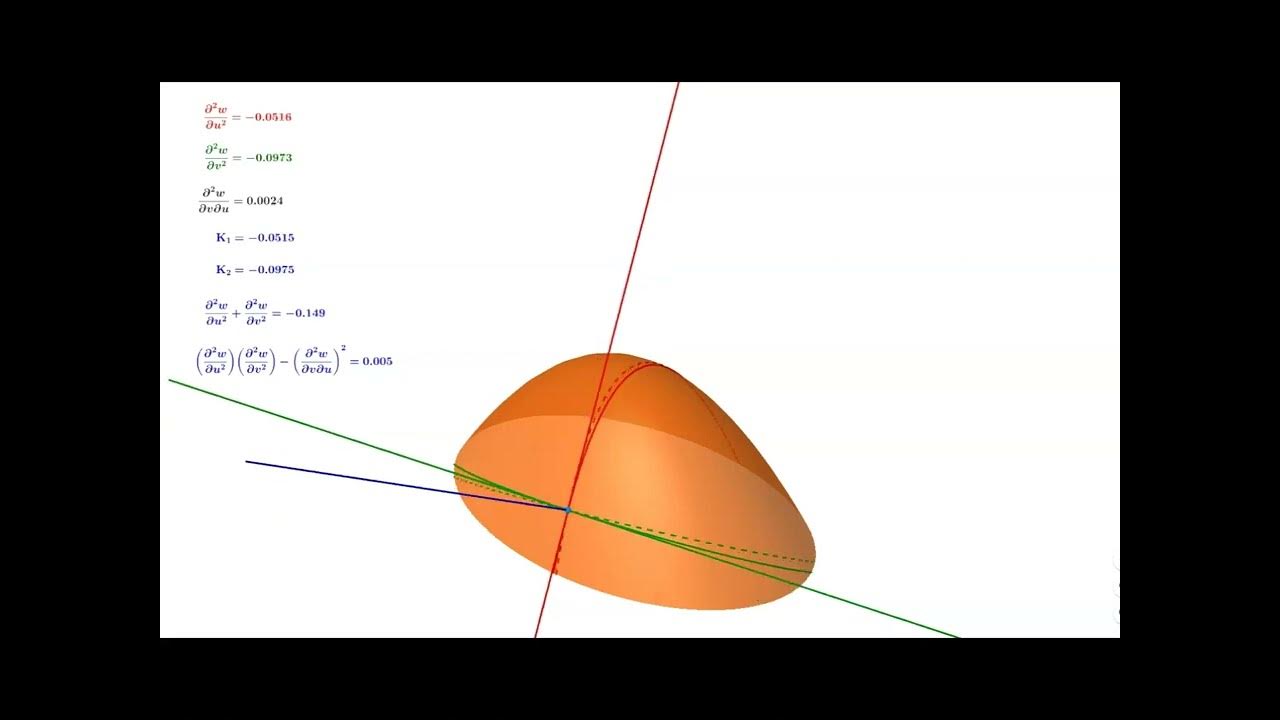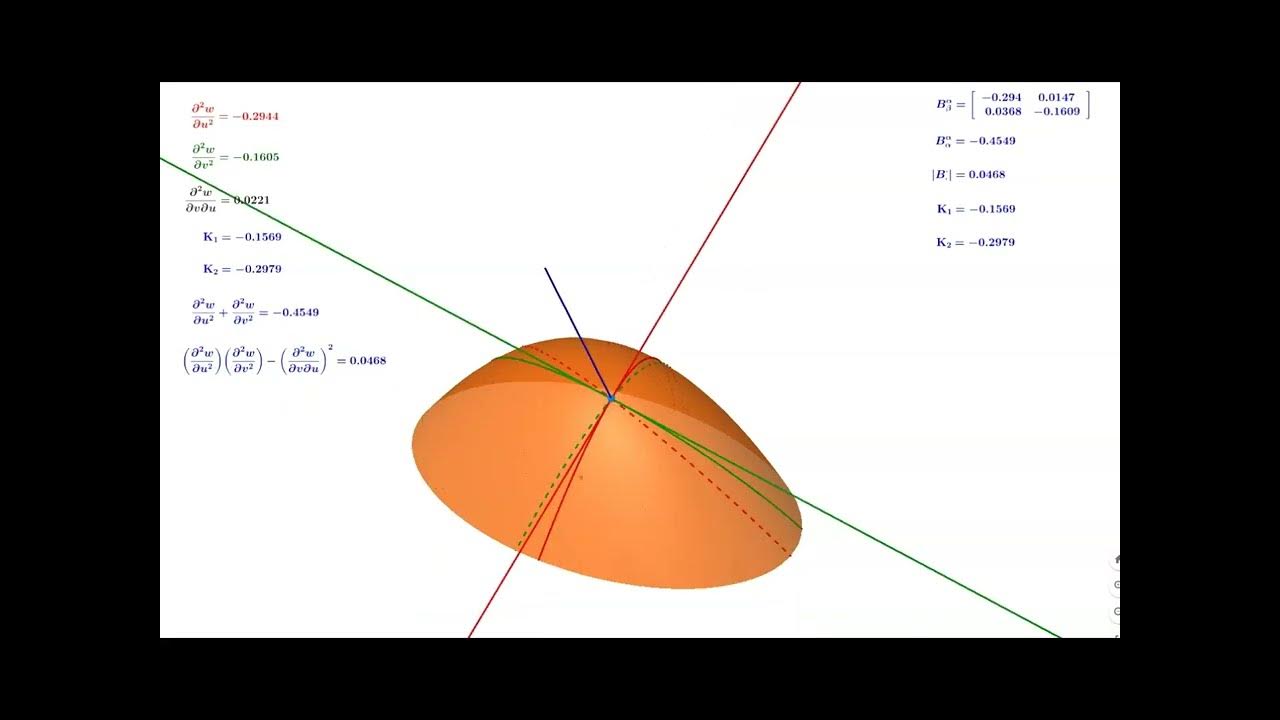Tensor Calculus Lecture 8c: The Curvature Tensor On The Sphere Of Radius R
TLDRThis script dives into the calculation of the curvature tensor for a sphere, emphasizing the importance of 3D visualization in differential geometry. It introduces the covariant basis vectors and metric tensor, leading to the computation of the curvature tensor and mean curvature. The discussion highlights the invariant properties of the Gaussian curvature and principal curvatures, showcasing the power of tensor calculus to derive geometric invariants without relying on specific coordinate systems.
Takeaways
- 📚 The script discusses calculating the curvature tensor for a sphere of radius R, emphasizing the importance of 3D visualization skills in differential geometry.
- 🌐 The sphere is described with two angles, theta and phi, where theta is the polar angle from the North Pole and phi represents the longitudinal lines of constant latitude.
- 🔍 The covariant basis vectors are derived by considering the rate of change of the position vector with respect to each angle, resulting in vectors pointing south and east respectively.
- 📏 The metric tensor is constructed using the lengths of the covariant basis vectors, which are R for s1 and R sine(theta) for s2, leading to a diagonal matrix with these values.
- 🧩 The contravariant metric tensor is the inverse of the covariant metric tensor, featuring R^-2 and R^-2 sine^-2(theta) as its non-zero entries.
- 📉 The area element of the sphere is given by the square root of the determinant of the metric tensor, resulting in R^2 sine(theta).
- 🔍 The normal vector to the sphere is discussed, with a focus on choosing the exterior normal for closed surfaces like a sphere.
- ️ The covariant derivative of the normal vector is calculated by taking partial derivatives with respect to each coordinate, which simplifies to the direct rate of change due to the normal being an invariant.
- 🔢 The curvature tensor is derived, showing how it changes with respect to the chosen coordinates, and highlighting the symmetry and orthogonality of the basis vectors.
- 🔑 The mean curvature of the sphere is calculated, revealing it to be -2/R when considering the exterior normal, indicating the sphere's concavity.
- 📈 The Gaussian curvature, an important invariant in differential geometry, is introduced as 1/R^2, emphasizing its significance in characterizing the sphere's curvature.
Q & A
What is the main topic discussed in the script?
-The main topic discussed in the script is the calculation of the curvature tensor for a sphere of radius R, as part of an undercover course in differential geometry.
Why is visualizing in 3D important in this context?
-Visualizing in 3D is important because it helps in understanding the concepts of differential geometry, such as the curvature tensor, which involves the manipulation and understanding of shapes and angles in three-dimensional space.
What are the two angles used to refer to a point on a sphere?
-The two angles used to refer to a point on a sphere are theta (the North South angle) and phi (the East West angle).
What is the significance of the covariant basis in this discussion?
-The covariant basis is significant because it helps in constructing the metric tensor and understanding the properties of the sphere, such as its curvature.
How is the covariant basis vector s1 related to the position vector when theta is kept constant?
-When theta is kept constant, the covariant basis vector s1 is related to the position vector by pointing in the direction perpendicular to the radius, effectively pointing south, and its length is R.
What is the role of the normal vector in the context of curvature tensor calculation?
-The normal vector is crucial in the calculation of the curvature tensor as it helps in determining the covariant derivative of the normal with respect to the coordinate system, which is essential for understanding the surface's curvature properties.
What is the meaning of the term 'exterior normal' in the script?
-The 'exterior normal' refers to the normal vector that points outward from the surface, which is a standard choice when dealing with closed surfaces like a sphere.
How is the mean curvature of a sphere calculated?
-The mean curvature of a sphere is calculated by taking the trace of the curvature tensor with one upper and one lower index, which results in a value of -2/R for the sphere with respect to the exterior normal.
What is the significance of the Gaussian curvature in differential geometry?
-Gaussian curvature is an extraordinarily important object in differential geometry as it is an invariant that describes the intrinsic curvature of a surface, and it has a profound geometric interpretation.
What are the principal curvatures and why are they important?
-Principal curvatures are the eigenvalues of the curvature tensor with one upper and one lower index. They are important because they have a geometric interpretation and can be defined without introducing a coordinate system, representing the surface's curvature characteristics.
How does the script relate the concepts of linear algebra to differential geometry?
-The script relates the concepts of linear algebra to differential geometry by discussing the properties of tensors, such as symmetry and self-adjointness, and by applying these properties to the calculation of invariants like mean curvature and Gaussian curvature.
Outlines
📚 Introduction to Curvature Tensor on a Sphere
The script introduces the concept of calculating the curvature tensor for a sphere of radius R. It emphasizes the importance of 3D visualization in differential geometry and suggests reviewing previous discussions on covariant basis in Euclidean space with polar coordinates. The sphere's coordinate system is described using angles theta and phi, with theta as the north sound angle and phi as the east-west angle. The script sets the stage for a deeper dive into the covariant basis vectors and the metric tensor, noting the symmetry with respect to phi.
📐 Understanding the Covariant Basis and Metric Tensor
This paragraph delves into the specifics of the covariant basis vectors on the sphere's surface. It explains how the position vector changes with respect to theta and phi, resulting in basis vectors that are perpendicular to the radius and lie on the tangent space. The metric tensor is constructed using the dot products of these basis vectors, revealing entries of R squared and R squared sine squared theta, with orthogonal vectors having zero entries. The contravariant metric tensor and the area element are also discussed, highlighting their significance in understanding the sphere's geometry.
🌐 Exploring the Normal Vector and Curvature Tensor
The script moves on to discuss the normal vector on the sphere's surface, focusing on the exterior normal for closed surfaces. It explains the covariant derivative of the normal vector and introduces the notation for the curvature tensor, emphasizing the need to specify the choice of normal when discussing curvature. The paragraph outlines the process of finding the curvature tensor by evaluating the rate of change of the normal vector with respect to the sphere's parameters.
🔍 Calculating the Rate of Change for the Normal Vector
This section provides a detailed explanation of how to calculate the rate of change of the normal vector with respect to theta and phi. It describes the normal vector as a unit vector rotating around the sphere and explains the geometric interpretation of its derivative. The paragraph breaks down the calculation into vertical and horizontal components, providing a clear visualization of the derivative's direction and magnitude.
📘 Deriving the Curvature Tensor and Mean Curvature
The script presents the calculation of the curvature tensor with one upper and one lower index, leading to the determination of the mean curvature of the sphere. It discusses the importance of the trace of the curvature tensor and how it relates to the mean curvature. The paragraph also touches on the convention of defining mean curvature and the significance of the result being negative when calculated with respect to the exterior normal.
📊 Discussing Invariants of the Curvature Tensor
This paragraph explores the invariants associated with the curvature tensor, including the trace and the determinant, which is referred to as Gaussian curvature. It explains the importance of these invariants in characterizing the geometric properties of the sphere. The script also introduces the concept of principal curvatures as eigenvalues of the curvature tensor and their geometric interpretation, highlighting the historical development of these concepts.
🎓 Reflecting on the Power of Tensor Calculus
The final paragraph reflects on the power and utility of tensor calculus as a framework for calculating geometric properties like mean curvature and Gaussian curvature. It acknowledges the contributions of historical mathematicians in developing the concepts of curvature and emphasizes how tensor calculus simplifies these calculations, making them accessible beyond the realm of exceptional mathematical talent.
Mindmap
Keywords
💡Curvature Tensor
💡Differential Geometry
💡Covariant Basis
💡Metric Tensor
💡Normal Vector
💡Covariant Derivative
💡Mean Curvature
💡Gaussian Curvature
💡Principal Curvatures
💡Tensor Calculus
Highlights
Introduction to calculating the curvature tensor for a sphere of radius R, emphasizing the importance of 3D visualization skills in differential geometry.
Discussion of the kinematic picture involving vectors rotating at a constant rate around the sphere, relating to previous discussions on polar coordinates in Euclidean space.
Explanation of the covariant basis for the sphere, including the basis vectors corresponding to changes in theta and phi angles.
Derivation of the metric tensor for the sphere, including the orthogonality of the basis vectors and the calculation of the tensor entries.
Introduction of the contravariant metric tensor and its relationship to the covariant metric tensor through matrix inversion.
Calculation of the area element for the sphere, highlighting its dependence on the sine of the theta angle.
Introduction of the normal vector and the choice of the exterior normal for the curvature tensor calculations on closed surfaces.
Explanation of the covariant derivative of the normal vector and its simplification to the partial derivative for the sphere.
Derivation of the curvature tensor components by evaluating the rate of change of the normal vector with respect to theta and phi.
Calculation of the mean curvature of the sphere, revealing its dependence on the sphere's radius R.
Discussion of the invariant properties of the curvature tensor and its significance in describing the geometric properties of the sphere.
Introduction of the Gaussian curvature as an important invariant, highlighting its role in characterizing the sphere's curvature.
Explanation of the relationship between the mean curvature, Gaussian curvature, and the eigenvalues of the curvature tensor.
Discussion of the principal curvatures and their geometric interpretation, emphasizing their significance in understanding the sphere's shape.
Mention of the alternative definition of Gaussian curvature and its equivalence to the derived form for surfaces embedded in Euclidean spaces.
Reflection on the power of tensor calculus in deriving geometric quantities such as principal curvatures and Gaussian curvature without extreme geometric intuition.
Concluding remarks on the importance of understanding the curvature tensor and its invariants in differential geometry.
Transcripts
Browse More Related Video

Video 78 - Gaussian Curvature

Tensor Calculus Lecture 14c: Non-hypersurfaces - Relationship Among The Shift Tensors

Video 80 - Curvature Tensor - Part 2

Tensor Calculus Lecture 8e: The Riemann Christoffel Tensor & Gauss's Remarkable Theorem

Tensor Calculus Lecture 8b: The Surface Derivative of the Normal

Tensor Calculus Lecture 14b: Examples of Curves in 3D
5.0 / 5 (0 votes)
Thanks for rating: